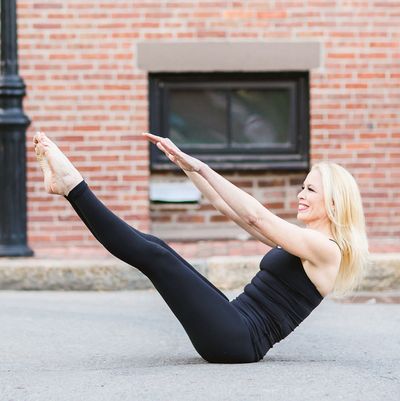
If there’s a savior of the Pilatespocalypse, it’s Julie Erickson. The first official Pilates trainer of the Knicks, Erickson is a staunch believer in a methodology she jokingly calls “type A” Pilates. It’s not so much Pilates on crack or for those who want ab ridges — it’s Pilates for the driven, and for a better life. “Your goal with Pilates isn’t to get better. It’s that Pilates lets you get better at everything you do,” says Erickson. If you’ve ever done a Pilates class on ClassPass and thought “meh,” it’s the exact opposite of that.
Running Endurance Pilates, Erickson has a devoted clientele teaching everyone from NFL players to models to Harvard medical school doctors. The Cut talked to Erickson about the biggest myths about the workout and how Pilates can teach you to constantly tone and engage your muscles — even when you’re watching TV, working on the computer, or seemingly doing “nothing.”
When did you start doing Pilates?
Over 22 years ago. In one of the magazines, I think, it said Madonna was doing it. I took a class, and I was in love with it. It made so much sense.
From being a dancer and gymnast, I constantly had back pain. In my early 20s, I was like, I don’t know if I’m going to be able to have kids, my lower back hurts all the time. But the second I started doing Pilates and learned how to use my core, it went away. You want to get to a point where your muscles are unconsciously competent at supporting you.
What does unconsciously competent mean? That you’re constantly engaging your muscles?
Basically. I’m not doing a mat class every day. But I’m engaging my abs the entire time I’m working with somebody or walking down the street. I’m sitting here right now, and I’m squeezing my butt, and engaging my core to engage my hip flexors. Getting those muscles to engage while I’m doing “nothing,” is getting better muscle tone and making me a stronger overall person.
What about when you’re watching TV?
I don’t really watch TV. If I’m working on my computer. I will have some deep abdominal engagement. I’ll pay attention and be like, What is going on with my back?
So you’re always engaging your muscles … except when you’re sleeping.
When I’m sleeping, yes. Or if I’m thinking about it, like in savasana — I try to let everything go there. That’s a time and place where I’m supported by the mat and floor. It feels safe for me to let go there.
How long does it take to be unconsciously competent?
It’s different for everyone. If people are doing a Pilates session like the kind I do where I am poking and prodding to make sure things are engaged, they pick it up in a couple of months — but they still need to think about it.
To get to the point where they are not thinking about it, it takes about a year. But then they’re able to use it when they’re scaling a mountain or doing everyday things. Their abs are just always turned on. And abs are different from a six-pack.
How so?
You have your deepest layer of core muscles, called the transversus abdominus. Those muscles work like a corset. Then the rectus, the six-pack muscle. I can’t tell you how many athletes — they’ve got six, eight, ten, twelve packs, but they have no core strength. They’re the first to admit it too. The outer abs is like having one very defined muscle, and the underneath, not so much. You can do all the core work in the world but never get to those deep, core muscles.
Hockey players especially don’t have much core strength. They have the outward structure, but it’s usually back muscles being overworked, and big glutes. People who work with their bodies for a living, it doesn’t take a year to be unconsciously competent. It takes a few sessions.
People often talk about different “workout” bodies. What does the “Pilates” body look like?
I’m 44. It’s looking taller, lifted, with good posture and core strength. Not all of us have six-packs but we do have dents in the side of the leg. It’s a little leaner with elongated muscles. It’s the tone that comes constantly engaging your muscles and elongating them.
How did you come to work with the Knicks?
I have all sorts of clients and age ranges, from my son to the youngest dancers in the studio to people in their 70s. It’s really for everybody. Every body type will benefit.
I met with the Knicks strength coaches a couple times. For their games when I’m in town, I will work them them out here or over at Madison Square Garden. We’ll do a little bit of mat work to prime the muscles and get those kicked on. We will work on more slow-twitch, supportive muscles. For them, it’s about getting their core muscles so strong so that when they have to reach for a ball, they won’t hurt themselves. They’ll be so strong within that they’ll basically be ready to take a punch all the time.





